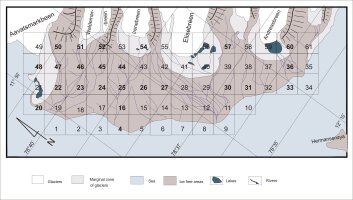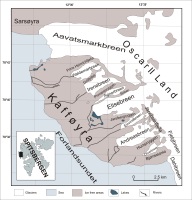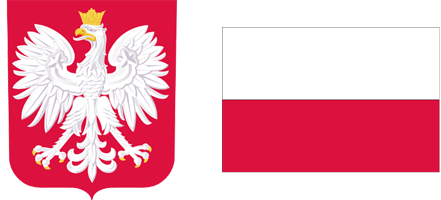. Introduction
The Peltigera Willd. genus includes mostly terricolous, macrolichens common in cold and temperate zones of both hemispheres, while in tropical areas they are limited to higher mountainous regions. Representatives of the genus are well distinguished by the presence of a large, foliose thallus, which is ecorticate and tomentose at the lower side and usually covered by dense rhizines growing up from distinct veins (Smith et al., 2009).
As many as 18 species of Peltigera were reported from the Svalbard (Øvstedal et al., 2009; https://nhm2.uio.no/botanisk/nxd/sval_L/sld_e.htm). So far, only a few data about these taxa have been known from the Oscar II Land region. The first data about Peltigera from the Kaffiøyra Plain were gathered during the Third Toruń Polar Expedition Spitsbergen in 1978 (Adamska et al., 1999). At that time, only three species were recorded on the Kaffiøyra Plain, such as P. rufescens (Weiss) Humb. as common in the region, P. leucophlebia (Nyl.) Gyeln. together with P. malacea (Ach.) Funck as the rare species. In addition, on the neighboring island of Hermansendya, P. canina (L.) Willd. was found (Adamska et al., 1999). Adamska et al. (1999) reported 85 lichen species growing on the plain in 1978. There was no mention in the available literature of any lichenological research carried out on Kaffiøyra before 1978, the third expedition. No other species of lichens of the Peltigera genus were recorded during the next lichenological research in the small part of Kaffiøyra Plain, near the Irena Glacier area (Wietrzyk et al., 2017).
Only several species have been recorded in the Kaffiøyra Plain area. Compared to the species list from Svalbard, it seems this is not a complete list. Therefore, the reason for undertaking the research was to start broader research that supplements knowledge about the list of lichen species and their assessment. Results presented here show compiled data on Peltigera species diversity occurring at the end of the 20th century on Kaffiøyra Plain.
. Material and methods
The Kaffiøyra (78°35′N–78°41′N, 11°50′E–12°20′E) is the coastal terraces plain, being a part of the Oskar II Land, lying on the NW coast of Spitsbergen, the largest island of the Svalbard archipelago (Figure 1). It is bounded on the west by the Forlandsundet Sea strait and on the east by mountain massifs not exceeding 950 m a.s.l. To the north, its natural boundary is Hornbaekbukta Bay and Aavatsmark Sea Glacier, and in the south Formsundet Passage and the Dahl Sea Glacier. Kaffiøyra Plain is 15 km long and 1.5–4 km wide. Seven glaciers come down to the plain from the mountain region. Several glacier rivers cross this plain. Due to the specific geology, relief, glacier activity, and other characteristic features of the natural environment, it creates a very diverse geoecosystem (Giżejewski et al., 2013; Kowalska et al., 2022; Niewiarowski & Myzyk, 1983; Niewiarowski et al., 1993; Sobota et al., 2013). In the study area, five types of arctic tundra have been distinguished. There is the tundra of deflation areas, lichen tundra, dry moss tundra, fresh moss tundra, and snowed tundra (Adamska et al., 1999; Gugnacka-Fiedor & Noryśkiewicz, 1982). From the geobotanical point of view, the study area has been classified as the northern arctic-tundra zone (Elvebakk, 1989, 1997).
This study is based on materials collected by the first author and Wanda Gugnacka-Fiedor during the summer season of 1997 (13th Toruń Polar Expedition) in the Kaffiøyra Plain. The area of the Kaffiøyra Plain was divided into 61 squares, and each square covered an area of 1 km2 (Figure 2). The methodology of working in a square grid results from the common methodological assumptions of the 13th research expedition. It assumed repeatability and comparability of research for the studied groups of organisms. This division ensured even exploration of the area. And it also provided the possibility of future monitoring. The lichen fieldworks were conducted in each square, and different habitats were treated as various localities in a square. Herbal materials were deposited in Nicolaus Copernicus University in Toruń (TRN). Some voucher specimens were in the herbarium at the W. Szafer Institute of Botany PAS in Krakow (KRAM L).
Figure 2
Distribution of study squares on the coast of the Kaffiøyra Plain. The numbers of squares with Peltigera are in bold on the map.

The occurrence and distribution of Peltigera species in Svalbard were prepared based on the papers Elvebakk and Hertel (1996) and Øvstedal et al. (2009). The nomenclature follows Øvstedal et al. (2009) and MycoBank (2024). The following monographs were used as a guide: Brodo et al. (2001), Smith et al. (2009), Thomson (1984), and Wirth (2013). The morphology and anatomy were examined using a standard stereomicroscope Nikon SMZ 645 and a compound microscope Nikon Eclipse E200. Measurements were made in water or c. 5% KOH. For the specimens of Peltigera frippii Holt.-Hartw. and P. neckeri Hepp ex Müll. Arg. lichen secondary substances were determined in solvents A and C using TLC, following Orange et al. (2001). The compared materials deposited in KRAM L and confirmed by J. Miądlikowska (1999) were also used.
. Results
On Kaffiøyra Plain, Peltigera species were noted in 24 squares (Figure 2; the number of the square with Peltigera genus representatives has been bolded on the map). 12 taxa were recorded altogether: P. aphthosa (L.) Willd., P. canina, P. didactyla (With.) J.R. Laundon, P. frippii, P. kristinssonii Vitik., P. leucophlebia, P. lyngei Gyeln., P. malacea, P. neckeri, P. polydactylon (Neck.) Hoffm., P. ponojensis Gyeln., P. rufescens. Except for 3 species (P. leucophlebia, P. malacea, and P. rufescens), all the remaining species are new to Kaffiøyra Plain. The most frequently recorded species were P. canina (9 localities), P. malacea (9), P. ponojensis (9) and P. rufescens (9). The greatest species diversity occurred on Sander of Waldemar Glacier, where as many as 10 species were recorded. An average of five species per square in this region were noted.
Peltigera aphthosa (L.) Willd.
Species reported from one locality, among stones on the moraine.
This species can be easily distinguished by the presence of cephalodia on the upper surface and the lack of veins on the lower side.
Specimen examined. NW Spitsbergen, Oscar II Land, Kaffiøyra Plain: Waldemarbreen moraines, 78°40′17.91″N/11°58′23.41″E, (51S), leg. E. Adamska & W. Gugnacka-Fiedor (TRN).
Peltigera canina (L.) Willd.
Species reported from nine localities, on the tundra area among stones, on an outcrop of rocks.
A tomentose upper surface and pale lower side with pale branched rhizines distinguished this species.
Specimens examined. NW Spitsbergen, Oscar II Land, Kaffiøyra Plain: Irenebreen moraines, 78°38′39.65″N/11°53′49.98″E (16S), and 78°39′20.04″N/11°57′56.77″E (44S), leg. E. Adamska & W. Gugnacka-Fiedor (TRN); Elisebreen moraines, 78°38′20.80″N/12°01′7.90″E (27S), leg. E. Adamska & W. Gugnacka-Fiedor (TRN); Waldemarbreen moraines 78°40′24.89″N/11°52′29.00″E (22S) (KRAM L 70416), 78°40′11.27″N/11°54′19.81″E (23S), 78°39′41.18″N/11°54′12.55″E (23S), 78°39′56.46″N/11°53′59.02″E (23S), 78°39′53.83″N/11°58′7.60″E (45S), 78°40′24.91″N /11°57′58.09″E (51S) leg. E. Adamska & W. Gugnacka-Fiedor (TRN).
Peltigera didactyla (With.) J.R. Laundon
Species reported from one locality on mosses among stones.
This species is easily distinguished by the presence of soralia on the upper tomentose surface. Another species with soralia on Svalbard is P. collina (Ach.) Schrad. but it differs in its marginal soralia and lack of tomentum on the upper side.
Specimen examined. NW Spitsbergen, Oscar II Land, Kaffiøyra Plain: Irenebreen moraines, 78°38′52.89″N/11°57′36.37″E (25S), leg. E. Adamska & W. Gugnacka-Fiedor (TRN).
Peltigera frippii Holt.-Hartw.
Species reported from three localities, on mosses and among stones in the tundra area.
This species is distinguished by phlebic acids (Øvstedal et al., 2009), the lack of isidia and soredia, and the presence of upper side smooth, glossy, and brownish, and venation fan-shaped. In the study, phlebic acid A was detected.
Specimens examined. NW Spitsbergen, Oscar II Land, Kaffiøyra Plain: Waldemarbreen moraines, 78°40′34.81″N/11°55′47.88″E (47S), 78°39′55.81″N/12° 0′49.32″E (52S), leg. E. Adamska & W. Gugnacka-Fiedor (TRN); Eivindbreen and Elisebreen moraines, 78°37′40.12″N/12°10′15.07″E, (57S), leg. E. Adamska & W. Gugnacka-Fiedor (TRN).
Peltigera kristinssonii Vitik.
Species reported from four localities, among mosses and on necked rocks on one site (square no.52).
This species has the upper side towards margins with thin, erect tomentum and minutely scabrous, lower side distinctly veined, interstices rounded, dark rhizines, in marginal parts richly branched.
Specimens examined. NW Spitsbergen, Oscar II Land, Kaffiøyra Plain: Irenebreen moraines, 78°38′56.68″N/11°58′22.26″E (25S), leg. E. Adamska & W. Gugnacka-Fiedor (TRN); Waldemarbreen moraines, 78°40′29.93″N/11°58′17.56″E (51S), 78°39′55.81″N/12° 0′49.32″E (52S), leg. E. Adamska & W. Gugnacka-Fiedor (TRN); Agnorbreen and Irenebreen moraines 78°39′9.09″N/12° 5′6.68″E (54S), leg. E. Adamska & W. Gugnacka-Fiedor (TRN).
Peltigera leucophlebia (Nyl.) Gyeln.
Species were reported from two localities, from upper altitudes; one site was on the highest terrace on a slope Gråfjellet, and the other was below the top of Prins Heinrichfjella.
This species is distinguished by the presence of cephalodia on the upper surface and veins on the lower side. Another species with cephalodia and vains is P. ventosa (L.) Hoffm. (not found in the study area), that is distinguished by small size, up to 2 cm in diameter.
Specimens examined. NW Spitsbergen, Oscar II Land, Kaffiøyra Plain: Waldemarbreen moraines, 78°39′58.69″N/11°58′31.02″E (45S), leg. E. Adamska & W. Gugnacka-Fiedor (KRAM L 70417, TRN); Aavatsmarkbreen and Waldemarbreen moraines, 78°41′13.84″N/11°58′29.92″E (50S), leg. E. Adamska & W. Gugnacka-Fiedor (TRN).
Peltigera lyngei Gyeln.
Species reported from five localities rather from upper altitudes, such as higher terraces or tundra hills.
This species is distinguished by the absence of cephalodia and veins and by the presence of scabrous upper surface.
Specimens examined. NW Spitsbergen, Oscar II Land, Kaffiøyra Plain: Irenebreen moraines, 78°38′38.05″N/11°53′40.80″E (4S), leg. E. Adamska & W. Gugnacka-Fiedor (TRN); Waldemarbreen moraines, 78°39′26.31″N/11°54′46.22″E (24S), 78°39′37.05″N/11°56′58.95″E (24S), 78°39′58.69″N/11°58′31.02″E (45S), 78°40′21.34″N/11°56′49.20″E (46S), leg. E. Adamska & W. Gugnacka-Fiedor (KRAM L, TRN).
Peltigera malacea (Ach.) Funck
Species were reported from nine localities, near glaciers and moraines, on soil, in the tundra, and among stones.
This species is distinguished by the absence of cephalodia, veins, and scabrous upper surface, and the presence of upper side tomentose, at least in the marginal part.
Specimens examined. NW Spitsbergen, Oscar II Land, Kaffiøyra Plain: Andreasbreen moraines, 78°36′25.91″N/12° 5′56.31″E (31S) (TRN), 78°35′54.45″N/12°16′7.51″E (60S) (KRAM L 70418, TRN), 78°35′50.27″N/12°14′14.23″E (36S) (TRN), leg. E. Adamska & W. Gugnacka-Fiedor; Eivindbreen and Elisebreen moraines, 78°37′54.28″N/12°11′16.04″E (57S), leg. E. Adamska & W. Gugnacka-Fiedor (TRN); Waldemarbreen moraines, 78°39′37.05″N/11°56′58.95″ E (24S), 78°39′53.83″N/11°58′7.60″E (45S), 78°40′21.34″N/11°56′49.20″E (46S), tundra border 78°40′17.53″N/11°58′7.21″E (51S), stones and rocks 78°40′17.91″N/11°58′23.41″E (51S), leg. E. Adamska & W. Gugnacka-Fiedor (TRN).
Peltigera neckeri Hepp ex Müll. Arg.
Species reported from four localities, on tundra, on soil over mosses.
This species is similar to P. frippii but differs in the absence of phlebic acids, the presence of the upper side bluish, and venation reticulate.
Specimens examined. NW Spitsbergen, Oscar II Land, Kaffiøyra Plain: Elisebreen moraines, 78°38′28.91″N/11°59′51.21″E (27S), leg. E. Adamska & W. Gugnacka-Fiedor (TRN); Waldemarbreen moraines, 78°40′19.49″N/11°53′53.50″E (22S), 78°39′53.83″N/11°58′7.60″E (45S), 78°40′3.69″N/11°58′16.86″E (46S), leg. E. Adamska & W. Gugnacka-Fiedor (TRN).
Peltigera polydactylon (Neck.) Hoffm.
Species reported from three localities, among mosses over soil and detritus.
This species is distinguished by a smooth, glossy brownish upper surface and a lower surface with flattened veins with rounded, white interstices, veins at marginal parts yellowish at center brown to black.
Specimens examined. NW Spitsbergen, Oscar II Land, Kaffiøyra Plain: Andreasbreen moraines, 78°35′37.24″N/12°11′3.03″E (33S), leg. E. Adamska & W. Gugnacka-Fiedor (TRN); Irenebreen moraines, 78°39′20.04″N/11°57′56.77″E (44S), leg. E. Adamska & W. Gugnacka-Fiedor (KRAM L 70359, TRN); Waldemarbreen moraines, 78°39′55.81″N/12° 0′49.32″E (52S), leg. E. Adamska & W. Gugnacka-Fiedor (TRN).
Peltigera ponojensis Gyeln.
Species reported from nine localities, among mosses over soil.
This species is characterized by a tomentose upper surface and pale lower side with pale, simple rhizines at the margin and elevated veins.
Specimens examined. NW Spitsbergen, Oscar II Land, Kaffiøyra Plain: Andreasbreen moraines, 78°35′37.24″N/12°11′3.03″E (33S), leg. E. Adamska & W. Gugnacka-Fiedor (KRAM L 70360, TRN); Elisebreen moraines, 78°38′20.80″N/12° 1′7.90″E (27S), 78°36′49.67″N/12° 6′26.97″E (30S), leg. E. Adamska & W. Gugnacka-Fiedor (TRN); Elisebreen and Irenebreen moraines, 78°38′32.09″N/11°58′37.37″E (26S), leg. E. Adamska & W. Gugnacka-Fiedor (TRN); Irenebreen moraines, 78°38′39.65″N/11°53′49.98″E (16S), leg. E. Adamska & W. Gugnacka-Fiedor (TRN); Waldemarbreen moraines, 78°40′41.21″N/11°49′42.84″E (20S), 9′37.05″N/11°56′58.95″E (24S), 78°39′58.69″N/11°58′31.02″E (45S), 78°40′24.91″N/11°57′58.09″E (51S), leg. E. Adamska & W. Gugnacka-Fiedor (TRN).
Peltigera rufescens (Weiss) Humb.
Species reported from nine localities, among mosses and on bare soil between pebbles.
This species is similar to P. canina but differs in rhizines soon darkened, and its lobe-ends are upturned.
Specimens examined. NW Spitsbergen, Oscar II Land, Kaffiøyra Plain: Waldemarbreen moraines, 78°40′41.21″N/78°40′41.21″N (20S), 78°40′30.10″N/11°50′8.96″E (20S), 78°40′24.89″N/11°52′29.00″E (22S), 78°40′14.71″N/11°57′13.75″E (46S), 78°40′15.94″N/78°40′15.94″N (52S), leg. E. Adamska & W. Gugnacka-Fiedor (TRN); Irenebreen moraines, 78°39′20.04″N/11°57′56.77″E (44S), leg. E. Adamska & W. Gugnacka-Fiedor (TRN); Aavatsmarkbreen moraines, 78°41′2.47″N 11°53′50.84″E (48S), leg. E. Adamska & W. Gugnacka-Fiedor (TRN); Agnorbreen and Irenebreen moraines, 78°39′12.87″N/12° 3′6.71″E (54S), leg. E. Adamska & W. Gugnacka-Fiedor (TRN); Eivindbreen and Elisebreen moraines, 78°37′40.12″N/12°10′15.07″E (57S), leg. E. Adamska & W. Gugnacka-Fiedor (TRN).
. Discussion
Compared to the previous expedition, where three species of Peltigera were found in the study area (Adamska et al., 1999), it seems that the squares method allowed for recording numerous new quantitative and qualitative lichen data. Furthermore, dividing the study area into quadrants allowed data to be collected for long-term studies and a comparable database to be created. Long-term monitoring associated with community mapping is essential in lichen dynamics resulting from habitat changes, including climate. Dividing the study area into quadrats allowed data to be collected evenly across the area.
The number of species in the square with present Peltigera hesitated from one to six. The squares with only one species were six, such as no. 4 on the seaside beach with P. lyngei, four on the tundra, nos. 26 and 30 with P. ponojensis, and nos. 36 and 60 with P. malacea, and square no. 50 with P. leucophlebia on the lower peak of Prinz Heinrich between Aavatsmarkbreen and Waldemarbreen. The most significant number of Peltigera species were recorded in square no. 45 (P. canina, P. leucophlebia, P. lyngei, P. malacea, P. neceri, and P. ponojensis) in the area encompassing the highest terrace at Gråfjellet and on a rocky outcrop below Gråfjellet. Five species were noted in square no. 51 (P. aphthosa, P. canina, P. kristinssonii, P. malacea, and P. ponojensis) on the Waldemarbreen on rocks on the border of the tundra.
Of the 12 species of Peltigera noted during this study on the Kaffiøyra Plain, only three were recorded previously: Peltigera leucophlebia, P. malacea, and P. rufescens. Pelitgera malacea was reported at that time only on one site in the N part of Kaffiøyra (Adamska et al., 1999). During this study, it was recorded on nine sites in three main moraines of Glacier: the Waldemar, Eivind, and Andrea.
Similarly frequent were P. canina and P. ponojensis, the second mentioned species unknown earlier from that Spitsbergen region, which was recorded on nine sites of the plain, but P. ponojensis was found mainly in lower localities closer to the seashore whereas P. canina mainly in the area between Waldemar and Irena Glaciers. This species was known before 1997 on neighboring Hermansenøya Island, on one site among mosses in the Saxifraga oppositifolia-Drepanocladus uncinatus community (Adamska et al., 1999). Peltigera rufescens is the species reported to be frequent in the plain in both periods. It was frequently found in various tundra communities, among mosses, especially on the hummocks tundra.
The third previously known species, Peltigera, in this area was P. leucophlebia, which was found during the third expedition in two localities on the Kaffiøyra Plain (Adamska et al., 1999). One site was on soil and mosses in the moraines of Aavatsmark Glacier, and the other was on the highest marine terrace in the central part of Kaffiøyra, in the community with Poa alpina subsp. vivipara. During this research, it was also reported from two sites, from higher localities of the Aavatsmark Glacier area below the top of Prins Heinrichfjella and closer to the center of the plain, on the highest terrace on a slope of Gråfjellet.
In the Svalbard archipelago, Peltigera lyngei was reported last time at one site on the neighboring island, Prins Karls Forland (Konoreva & Chesnokov, 2023). In that study on the Kaffiøyra Plain, the species was found on five sites on the moraines of Waldemar Glacier.
The other Peltigera species on the plain were noted one to four times, mainly in one area between Waldemar and Irena Glaciers.



